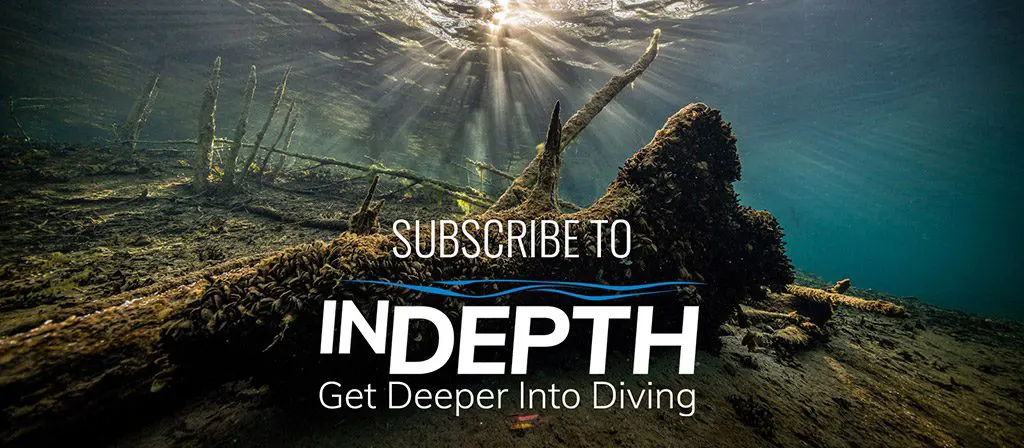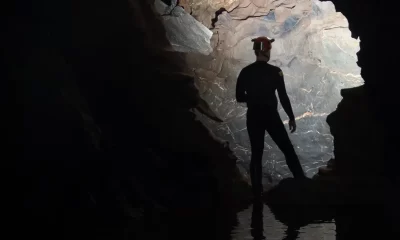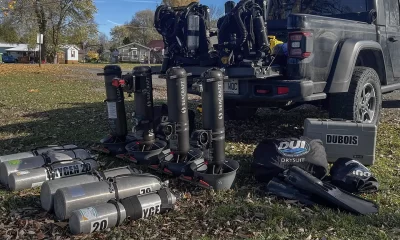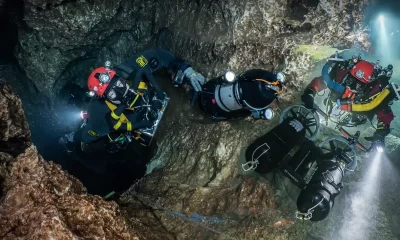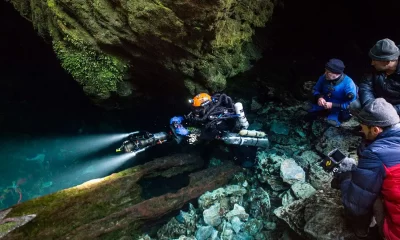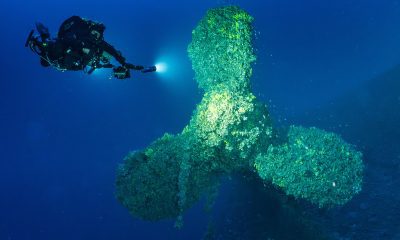
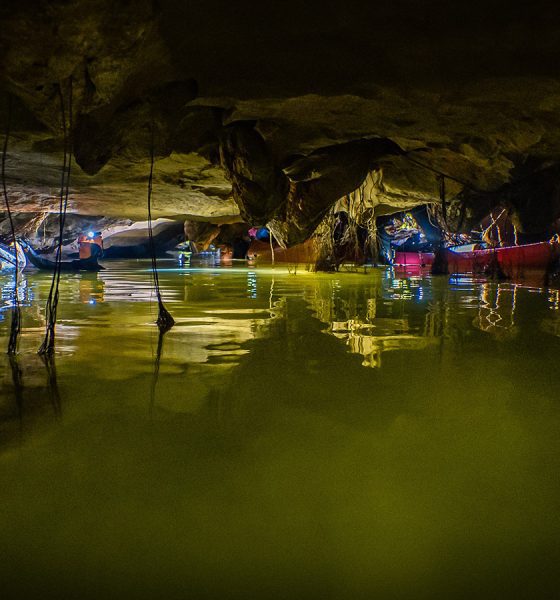
Cave
Discovering The Longest Fresh Water Cave In Thailand
In February, explorer and instructor Mikko Paasi and his crew from Bottomline Projects Foundation were charged with investigating the source of water in Toh Wang cave in southern Thailand near the Malaysian border. Little did they suspect they would uncover a behemoth. In fact, it became clear after a series of exploration dives that Toh Wang was not only the longest underwater cave in Thailand, but it was part of an underground cave system that might connect five new sinkholes in the surrounding area. Paasi reports on their find.
Text and images by Mikko Paasi. Header image: The only reminder to the outside world is the roots of the trees above that reach out for water and give shelter to the small cave creatures living in the constant darkness.
🎶 Pre-dive clicklist: Respectness by Seeed🎶
Toh Wang cave in southern Thailand, right at the border of Malaysia, near the city of Satun, is a well known underwater cave for the locals. The villagers use it as a water source, the kids play in the pond outside the entrance, and the elders go inside to catch catfish and giant cave shrimps. The cave entrance is just a small crack in the face of the limestone mountain but, once inside, the cave widens out and takes a steady north heading, following the ridge of the Khao Phrayabangsa mountain.
The cavern part of the cave is shallow, and the ceiling is very low, so low that you can barely fit your helmet through some of the restrictions. It is also very long; the distance to the end of the cave was measured somewhere between 500 to 600 meters (1640-1967 ft) before it came to a dead end. This was what the villagers believed before our cave diver team from Bottomline Projects Foundation was tasked with investigating where the water was coming from.
Our connection and local guide was Folk Kamponsak Sassadee, an extraordinary explorer, and a climber, whom I knew from the Thai Cave Rescue. Then, in 2018, he was leading the search for an alternative exit for the trapped football team by climbing the sheer walls of the Khun Nam Nang Norn mountain. Folk was the heart and the impetus for this current expedition to find the water’s source. He recruited me to join the project. He also took care of all our needs and official permits to conduct exploration in National Park premises.
For many generations, Folk and his family have lived in the area, and they told us about a legend of a lost tribe who once lived in the mountains and rarely came down the mountain to the village. One of these tribe members had been Folk’s grandfather, who occasionally met with the light-skinned tribe members. This Phab Paew tribe vanished a few decades back during a pandemic and was never seen again. Only traces of their existence lie hidden in the sinkholes that can be found in the valley between the two mountain ridges the cave appears to follow.
Twenty-four years earlier,on his excursions Folk had observed some possible burial sites near those sinkholes but had failed to return to them. Consequently, the ultimate quest for our team was to find where the water originated and to determine if it was connected to those sinkholes. We hoped to also find evidence of the extinct Phab Paew tribe.
Taking the Plunge
Our first visit to the area was in mid-February this year, 2023. I, and our team of cave divers, live in Koh Tao, a small island in the middle of the Gulf of Thailand, where I have run my dive center Koh Tao Divers for over two decades now. We took a night ferry to the mainland and drove down to Satun near the Malaysian border. After 15 hours of travel, we were on the site, eager to go in and see if the cave really ends or if it continues. We met the local village leaders, Folk, and his team of explorers, who would be our safety on the surface while we explored underwater.
Our team consisted of four cave divers, Patrick Tassin, Klaus Könönen, Mika Lindström and me. We are all seasoned divers with a daily routine and thousands of dives under our belts. Topside we had Folk and his team of four park rangers. Yet, we were on an expedition together for the first time as a team and in an unknown location that no one ever dove before. We were literally performing an exploration that could end at a dead end or could lead to a sinkhole with burial sites of a lost civilization.
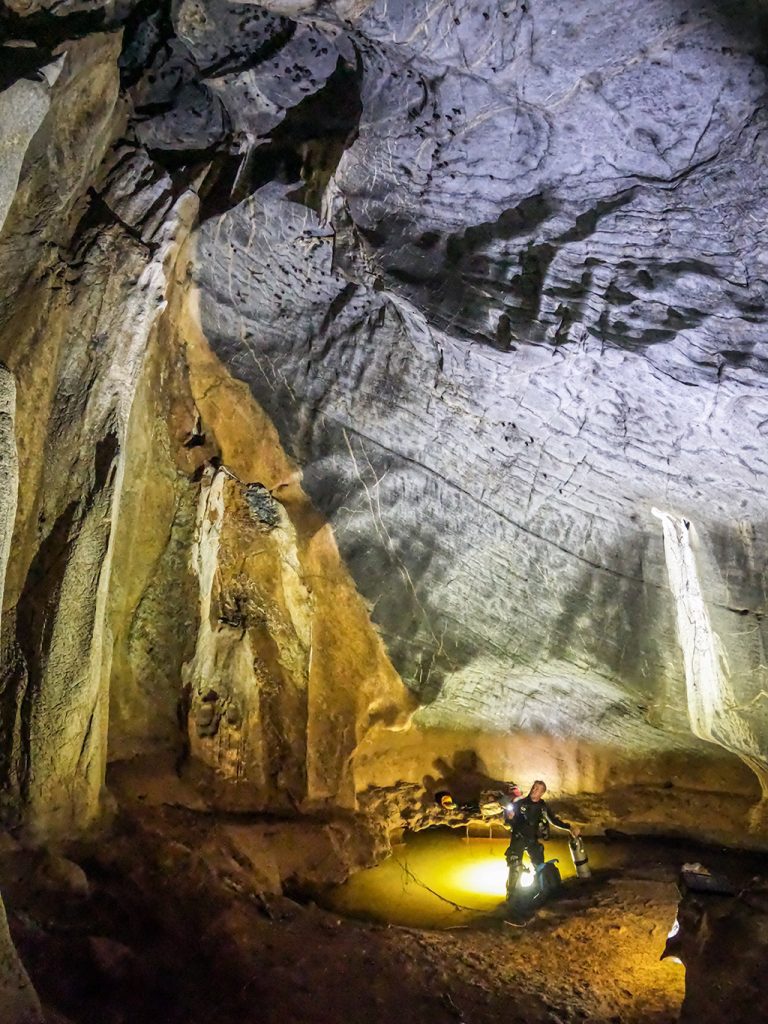
We hauled our tanks and camera gear into four kayaks and started to work our way to the end of the cavern zone. The way seemed much longer than only 500 m/1640 ft, as we had to swim and push the kayaks in front and through multiple restrictions while wearing closed circuit rebreathers (CCR) on our backs. Luckily, mine was the slimmest in the market, the Kiss Sidewinder mCRR, that weighs only 8kg but still allowed me to stay submerged for multiple hours adding safety and practicality to the team.
Once we reached the end, it was our turn to do what we do the best. Our plan was to take a look at the first chamber and collect general information of the topography and the conditions so that we could form a safe strategy for the second day.
Once all the checks were done, Patrick and I plunged in and started to lay the line. The atmosphere inside was eerie, and the walls reflected a warm yellow glow from our lights. The bottom was fine sand and clay, and the finest silt was oozing out from the walls. Depth was only around 5 m/16 ft, and we could see constant air chambers on the top, one after another. As we made our way forward and deeper toward the heart of the mountain, we came across fair-sized catfish and massive cave shrimps that were the size of a lobster. We noticed a few freshwater fish that don’t usually belong in caves but didn’t think of it too long, hoping that maybe there was a larger body of water this cave could be connected to. We emptied our reel and turned back, happy for the fact that the cave kept going and the conditions were better than we dared to dream for.
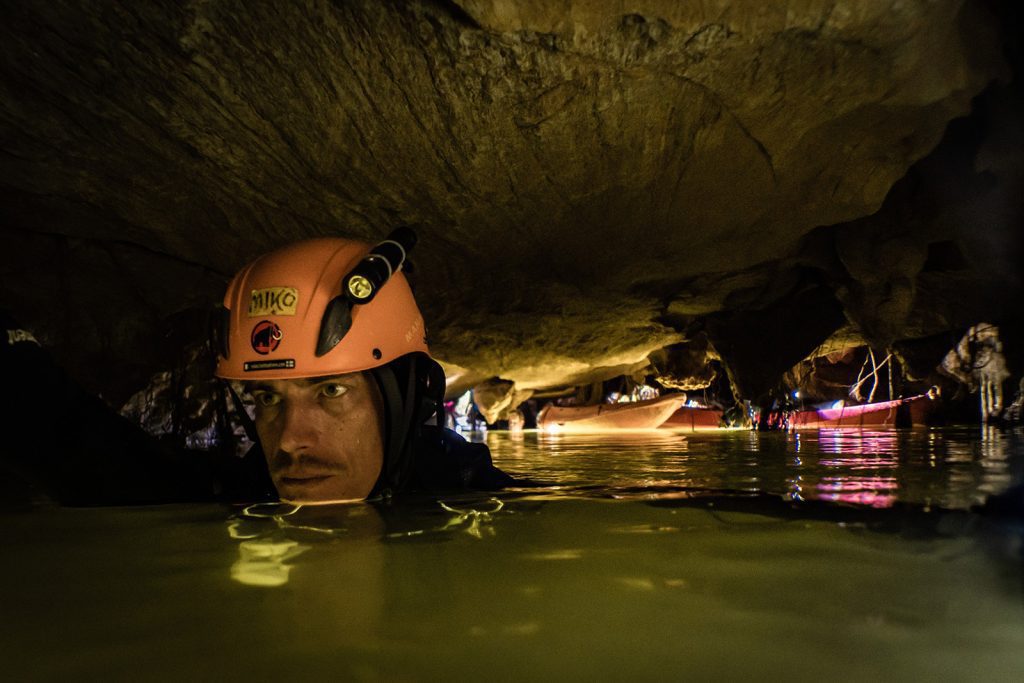
On the second day, the cavern part was a bit easier, since we had staged our cylinders in the far end the day before, and this time we had a better idea of what to expect. The visibility was reduced from the first day, but once we got to the end of our existing line and started to push new line again, the visibility got a bit better. Two teams of two divers in a cave like this, one that seemed to be going straight and remaining the same smallish size, was a bit uncomfortable if you popped into the other team.
Still, it was important to have one team pushing and the other collecting data from next to the already-laid line. By the end of the second day, we had laid some 300 m/985 ft of new line and extended the total known length of this water-filled cave by half. The best part being that there was no sign of the cave ending any time soon.
The local community was happy to hear what we had discovered and welcomed us back as soon as possible to continue to search for answers to their questions.
Gearing Up for a Second Push
Two weeks later we were back, and this time a bit better equipped. One of the leading technical CCR instructors and local cave explorer, Por Parasu Komaradat, joined us and brought a compressor, booster and his Optima CCR, so we could push further and with less gear to haul in and out. The conditions were the same as the time before, and so was our target, which was to see where this system went and what lay at the end of it.
I have to admit, while swimming for the fifth time, the distance from the cave mouth to where we started the dive was getting to be a bit of a task. It was fine for the first few times, but it lost its appeal after a two-hour dive and a total of five hours in the water. The first day we extended our current line by another 300 meters and there was still no end to be seen. I also took about 3000 photos of the cave itself on our way in to see if we could create a 3D photogrammetry map for further studies. The cave took a plunge to max depth of 18 m/60 ft and we saw a few junctions on the way.
The other team, Mika Lindström and Kevin Powers, explored the existing way and detected an exit from one of the air chambers about 700 m/2300 ft in, but it was impossible to climb out without any climbing gear. With still no sign of the end of the cave, we returned and drove back to our base camp to fill gasses and change the sorb in our breathers.
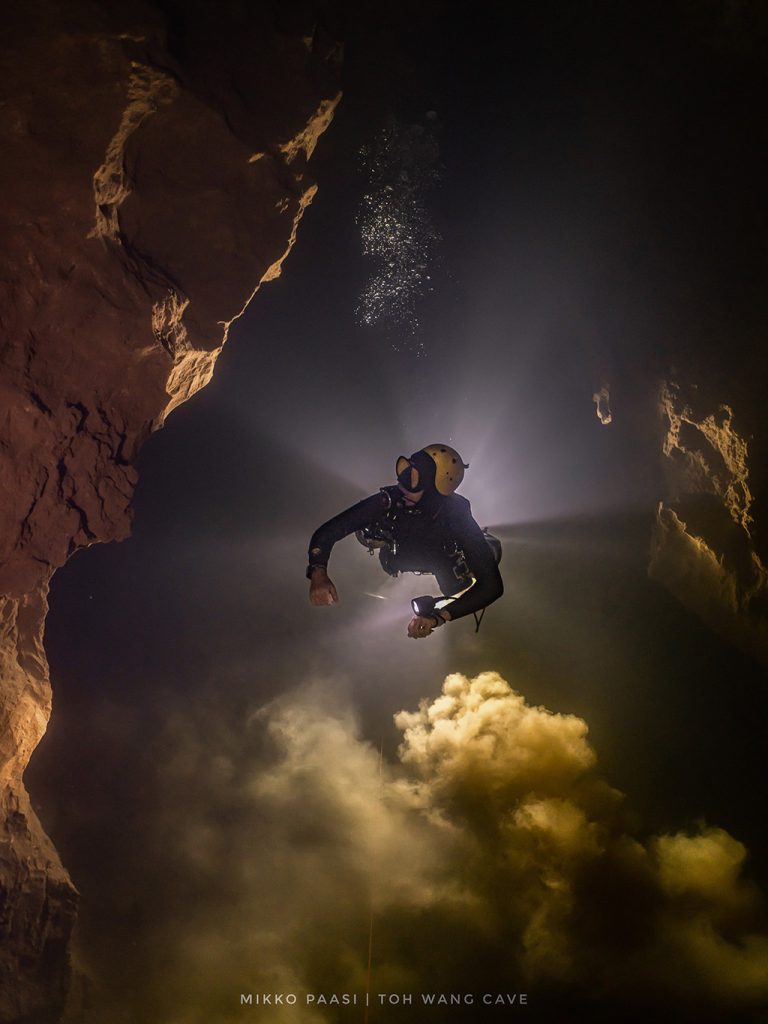
Day by day, and after every push dive, the logistics were getting harder. We then had to first swim about half a kilometer (1640 ft) to the end of the cavern and then dive another 600 m/1970 ft to the end of our line just to start pushing new line.
Water filled caves in Thailand are often deep but fairly short in distance, and during our fourth push dive in total we realized that we must be past the point of the longest cave system in the country. After emptying our last two reels we had now extended the previously known 600 meters to a total length of 1400 m/4600 ft, of which 800 m/2625 ft were fully submerged. Unfortunately we ran out of line and had to turn around. At that point, the cave seemed to have multiple passages to different directions, and it plunged to deeper depths with still no end in sight.
To our pleasant surprise and just when we were packing to drive back to our home island, Folk came up with a new plan that included a nearby cave that had a small pond of water inside but was so unknown that it didn’t have a name yet. What if this cave connected to Toh Wang? What if the monsoon rains started before we could come back again? What if someone else finished what we started? We just had to stay another day and see if the pond of water led somewhere. We were out of line, so overnight we knitted together all the loose bits we had and came up with a multicolored 100 m/328 ft reel.
Early in the next morning we were all excited about this new possible cave entrance and the fact that it was even closer to the sink holes than the Toh Wang cave entrance. We wondered if the two might connect at some point. We just needed to see if this one went as well.
The No Name cave entrance is located 5.1 kilometers (about 3 miles) northeast from the Toh Wang cave and only 600 m/1969 ft from the nearest sinkhole. We were optimistic and carried in half of our equipment on the first climb into the system. Once in, we could already see water flowing out, a very good sign. After 50 meters of crawling, we came to a massive marble chamber with thousands of bats who were disturbed by our bright diving lights and flew around. What a beautiful sight even after Folk told us that this cave was also home to a countless number of different snakes.
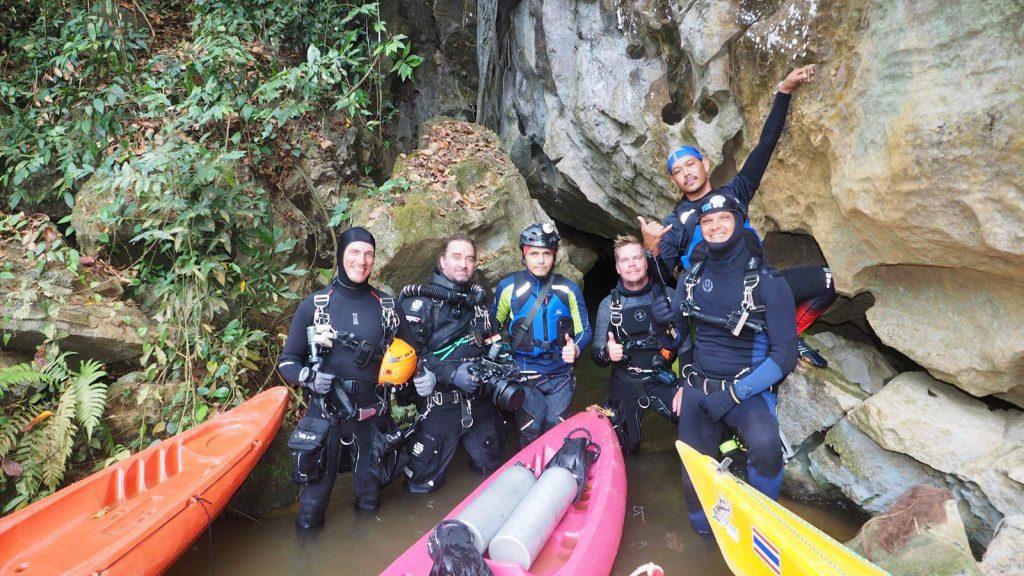
At the far end, we could see the little, 2 m/6.5 ft by 2 m/6.5 ft pond that might lead to an unknown destination. I understood that any non cave divers might not have been able to see the potential in this little pit, but we were even more excited than the cloud of bats whirling above us.
One hour later, we were all neck-deep in our little pond, full-on exploration mood, and ready to work our way to wherever the cave wanted to go, and for our pleasure, it went. After a 100 m/328 ft and way too soon, we ran out of line, did a final tie-off and turned the dive. We realized we had two new water-filled caves—both that kept going toward the sinkholes in the heart of the Khao Phrayabangsa Mountain.
Not only did we discover the longest fresh water cave in Thailand, but we also found a possible underground cave system that might connect all the five known sinkholes and perhaps give new light to the lives of and the mysterious disappearance of the Phab Paew people.
DIVE DEEPER
InDEPTH: A First Exploration of the Flooded Mines of Thailand by Mikko Paasi
InDEPTH: Diving Into History With Thailand’s Sira Ploymukda by Carlos Lander
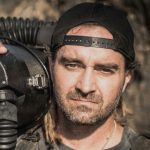
Mikko Paasi is an enthusiastic explorer, CCR cave/mine Instructor trainer and an underwater camera operator. His soon 30 year long professional diving career started at Ojamo mine, Finland, in the 90’s. Today he runs his dive center, Koh Tao Divers, in Thailand and conducts constantly new diving related projects and expeditions through his foundation called Bottomline Projects. Mikko has been involved in multiple documentaries and movies both, behind and in front of the camera, latest being a film called Ghost Ships which is now premiering in the Berlin Film Festival. He played a key role in the Thai Cave Rescue 2018 from where the King of Thailand awarded him with a 1st class Knight Grand Cross.



















